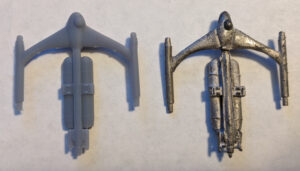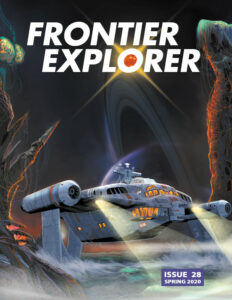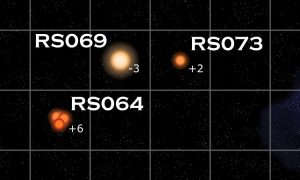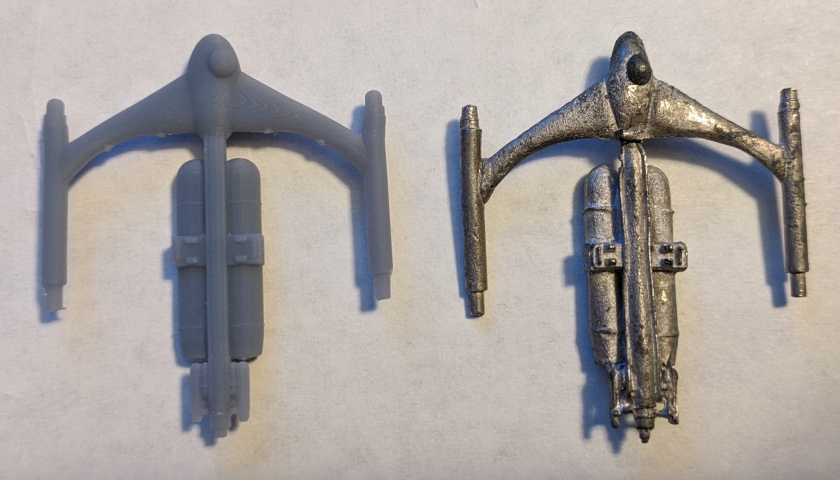This was not the post I had planned for this week but with all the precautions and closures due to the COVID-19 coronavirus the last few weeks, it got me thinking about medical technology and then about the differences between Frontier technology and our modern tech.
A Look at the Frontier
One thing that always stood out to me, even as a preteen/teenager
in the early 80’s was that the relative levels of technology in the Frontier
was very different from our own, and that was ignoring things like spaceflight,
laser guns, and FTL travel.
Take computers for instance, even in the early- to mid- 80’s,
the computer technology here on Earth was beyond that of the Frontier, or at
least on par with it. And looking at the
game with modern eyes, we are way beyond the Frontier tech.
Zeb’s Guide did a little to advance the computer technology
and shrink it down, with the introduction of the bodycomp. This helped to bring the tech somewhat in
line with what was available in the mid-80s.
But a visitor from the Frontier to Earth today would be amazed with our
modern computer technology.
However, if you look at Frontier medical technology, it is
light years ahead of even our modern medicine.
With just a handful of relatively inexpensive drugs, you can cure most
diseases, neutralize toxins, heal injuries, and even postpone death. Not to mention the freeze field and storage class
transport fields that can put you into indefinite suspended animation (as long
as the power doesn’t go out). These wonder
drugs would be a dream come true for medical professionals on Earth today.
I don’t know if it was a question really, more like an unsatisfied
curiosity, but I have always wondered and thought about why the Frontier went
down that technology path rather than the one we did. Why is the medical technology vastly beyond the
physical technology?
Game Play
At a practical level, it is what it is so that the game can
be exciting and playable. You need
advanced medical technology (just like you need healing spells in a fantasy
game) so that the PCs can get right back into the adventure after getting
hurt. And you don’t want the tech to be
so amazing that it overshadows the abilities of the characters.
In fact, it was either Larry Schick or Dave Cook, the
original creators of Star Frontiers, who, in an interview said that they set
the tech level where it was so that it was the PCs that had to do the tasks and
not be able to just call on the technology to solve all their problems. That was why they made the computers big and
clunky, with no real networking, and many of the other design choices that they
made.
That said, it is still a fun exercise to think about what
events we could work into the history of the Frontier to account for such a
balance of tech levels.
A Sweeping Pandemic
Which brings me back to COVID-19 and the events happening in
the world today.
In Zeb’s Guide, it talks about the Blue Plague and five worlds that were lost to this plague. While I either like or don’t mind many of the setting elements introduced in Zeb’s Guide, this is one that has never really sat well with me. So much so that I left those worlds off of my Extended Frontier Map completely. What where the original names of those systems? They wouldn’t have been called Alpha through Epsilon originally. Why weren’t they on the Frontier map from the original rules? They would have been in setting at the time in the history that the original game occupies. I understand the desire to expand the setting, but the way the Zeb’s Guide timeline was built made many of the things it presented inconsistent with the original game setting and modules.
I don’t like the placement that Zeb’s Guide gives to the
Blue Plague, occurring from 17-27 FY – after the original sathar invasion that
prompted the formation of the UPF. It
feels too late and tacked on. And I don’t
like that it wipes out five star systems that should have been part of the
Frontier history but were never mentioned in the original game.
But what if something like the Blue Plague happened, just
much, much earlier in the history of the region? Back when all the technology was young and
prompted a focus on the biological and medical sciences over the physical ones? That could have prompted the technology
development we see in the game.
Now you might argue that you need the physical and computer
tech advances to produce the medical ones, we definitely see technology aiding
medicine today. But we don’t know that it’s absolutely necessary. We only have one sample timeline. It didn’t work out that way for us, but that’s
not to say they path we took is the only one.
It’s time for a little willing suspension of disbelief.
The Blue Plague Revisited
So let’s dial the clock way back, to the early settlement of
the Frontier. In the Knight Hawks rules,
it states that the discovery of the FTL travel was an accident. It was completely unexpected. In my game it was the humans who stumbled upon
Void Jumping and shared it around. In
the process of exploring it, they discovered a signal from the Vrusk and went
to investigate. But because of its
accidental discovery, I have the human tech level originally set somewhere
around that of the late 60’s, early 70’s somewhat consistent with the computer
tech of the game. They just happened to
have developed better propulsion systems to get the necessary speeds.
Instead of hunkering down, they exploded throughout the region. There is a reason there are many more human worlds than those of the other races, and even then, you find humans almost everywhere. They had the ability to travel to the stars and they did, aggressively. The other races expanded outward as well, but not nearly as much. As I detailed my Yazirian Lore posts last month (part 1, part 2), the yazirians were expanding outward out of a sense of preservation. The vrusk and dralasites didn’t expand out nearly as much.
And then, shortly after all of these worlds were being
settled, the Blue Plague struck. In Zeb’s
Guide, it describes the plague as receiving its name due to its early symptoms:
large blue welts that appear about the face and extremities that leave horrible
black scars even if you survive the plague.
No one knows exactly where it came from. The first cases were on Prenglar, the hub of
the Frontier where travelers from all over mingle and visit. As more and more cases were discovered on
Gran Quivera, it began to be studied more, restrictions and quarantines were put
in place, and efforts were made to get it under control.
But by then it was too late.
The disease, having a very long incubation period, had already spread throughout
the Frontier and cases began popping up on every world. Due to the horrific nature of the plague as
well as the relatively high mortality rate, quarantines and restrictions became
very strict. Of course, this impacts
production, research, and distribution, especially of food. Because of the long incubation period,
coupled with the long duration of the illness itself, these quarantines ended
up lasting for a very long time. As many
people probably died of knock-on effects of these restrictions as died from the
Blue Plague itself.
One impact of the long duration of the plague was the development
of robot technology. Since the citizens
were afraid to come in contact with one another, something had to be done to
produce the goods and food needed to sustain the populations of the various
worlds. Thus, robot technology got a
huge boost. The early models were crude,
probably remotely operated, and not very sophisticated, but the plague launched
the nascent robotics industry that would continue to develop over the
intervening years.
More importantly, the Blue Plague resulted in a huge boost
in funding into medical research. This funding
came from everywhere. Governments heavily
supported it at the behest of their citizens.
Companies supported both to try to keep their workers and as a public relations
measure. And private citizens supported
it for a wide variety of reasons ranging from altruism to a desperate desire
for self-preservation.
Regardless of the reason, funding into the biological and
medical science boomed and universities and research institutions flourished. It took several years, but a cure was finally
found. Along the way, other interesting
avenues of research were uncovered but left unexplored in the rush to find the
cure. Eventually, all this research
payed off and the Blue Plague was eradicated.
Aftermath
After the Blue Plague was under control, the citizens of the
Frontier took stock of the situation and the results were horrifying. Millions dead across every world of the Frontier. Millions more permanently disfigured for
life. No one issued a proclamation, no
one passed any laws, but collectively as a Frontier-wide community, the people
resolved to never let this happen again.
The funding in the medical sciences, while never again as high a
proportion of the total wealth of the Frontier as during the Blue Plague itself,
remained very high.
Because of this high state of funding, all those interesting
side avenues that had been discovered during the Blue Plague research were able
to be pursued and developed. Over time,
this led to the development of the wonder drugs known in the modern Frontier as
Biocort, Simdose, Staydose, Omnimycin, Antibody Plus, and AntiTox. Six drugs that together can treat almost
anything the universe might throw at you.
Having seen the benefits of using robots for many of the
menial jobs required during the Blue Plague era, robotics continued to develop
a heightened state, although nowhere near the level of the medical
sciences. Effort was put into developing
robotic systems that could be autonomous and operate independently of direct
supervision but rather controlled by programming or robot management
software. This heightened development has
led to the relatively inexpensive and highly capable robots found in the Frontier
today.
Of course, the cost of this increased medical and robotics development
was a slowing of the development of the other technologies. Computers, vehicles, starships, and even
weapons systems fell behind the curve.
Advances were made, but not nearly at the pace of the robotics and
medical technologies. Thus we get the
technology levels presented in the game rules.
Using This in Your Game
If you chose to use this history in your version of the
Frontier, what impacts might it have in your game?
One aspect is survivors of the Blue Plague. Depending on how long you made the extended
history of the Frontier, and where you place the Blue Plague in that history,
there might still be survivors bearing all the scars of their ordeal. Personally, I don’t like the 400+ years of
the Zeb’s Guide Timeline and prefer to compress it much more than that. Making it
200 years at most. That allows me to
have the technology not as developed.
But that means, given the 175 – 250 year average lifespans for the
various Frontier species, there will be survivors of the Blue Plague still
around. They will be older, but could still
be active members of society. How do
they see the world? Do they have agendas
they push for? What stories do they have
to tell and how has their experiences shaped the way they look at the world?
The modern wonder drugs can solve almost any issue. What does that mean for all the companies
that have invested in the research side of things? Is research slowing down? Is the funding shifting? How does that impact the economy and the
people working in those industries?
Maybe there is funding slowly shifting to other areas? Are computers becoming smaller and more powerful,
starting to move along the path of our Earth technology? Is the money going other places? Or maybe there are occurrences of other
diseases like the Blue Plague that break out but never to the same extent that
require constant retooling of the medicines keeping the biotech industry alive
and well.
Is the Blue Plague really eradicated or do new cases pop up
occasionally around the Frontier? How do
people react when it happens? Are the causes
natural or contrived?
How did the enforced isolation required during the Blue Plague
era affect communities? Would the isolation
become standard? Would it cause an
increased awareness of the need for community?
Would it spark an increased care and understanding of the needs and
interests of one’s neighbors? Maybe it
did all of those on different worlds or in different communities. When you create a community for the PCs to interact
with, you might sprinkle in an unusual custom that dates from the time of the Blue
Plague.
What other ideas does this alternate timeline bring to mind? How else might you apply it in your game? Share your thoughts in the comments below.







